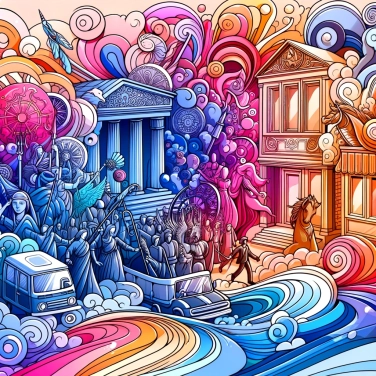Tribal tattoos in Polynesia have complex patterns due to their deeply symbolic cultural heritage and the rich artistic tradition of the region, where each pattern has a specific meaning.

In Polynesia, tribal tattoos are much more than mere designs: they represent an entire ancestral culture behind them. Originally, these complex patterns stem from very strong spiritual beliefs where each tattoo establishes a unique connection between the person, their ancestors, and their protective deities. These particular shapes often evoke sacred natural elements such as the ocean, animals (sharks, turtles, lizards), or certain abstract symbols representing concepts like strength, courage, and spiritual protection. Each motif etched into the skin is thus a true cultural and spiritual identity card, a precious heritage that one carries proudly throughout life.
Polynesian tattoos tell stories through their hyper-complex patterns, forming a true visual language. Each symbol, from the simplest to the most detailed, expresses important values such as family, courage, protection, or respect for ancestors. The turtle (honu), for example, often represents longevity and fertility, while the shark symbolizes strength and determination. The finer and more elaborate the symbols, the deeper and more personal their meaning becomes, recounting the key milestones of a life or significant moments of a warrior or a chief. Essentially, these patterns are never there by chance: they provide a true sense of identity to the person who bears them, like a visual identity card etched on the skin.
In Polynesia, the knowledge of tattooing is mainly transmitted orally, through stories, songs, and discussions within families or between master and apprentice. There are not really detailed writings or precise manuals: these are lived experiences, explained and repeated from generation to generation. The master tattooists, called tahu'a or tufuga, hold these techniques, ensuring cultural continuity. Each apprentice learns directly by observing, asking questions, and meticulously imitating each gesture. It is far from quick: it takes several years before the apprentice succeeds in grasping the finishes, the precise symbols, and mastering the use of traditional tools, such as the famous tattoo comb. This transmission of ancestral knowledge guarantees a richness and authenticity in the current complex designs.
Polynesians have long traveled extensively across the Pacific islands, bringing with them their traditions and motifs. These regular exchanges allowed for the merging and combining of different styles, gradually enriching the complexity of their tribal designs. Later, contact with Europeans also influenced these motifs: new tools, external graphic inspirations, and various cultural exchanges encouraged local tattoo artists to further refine their art. Today, Polynesian tattoos feature certain hybrid symbols that subtly reflect these historical encounters. These cultural interactions largely explain why Polynesian tattoos exhibit such a unique variety and graphic richness.
Today, complex Polynesian tattoos continue to attract significant interest worldwide. They far exceed island boundaries: specialized studios, tattoo artists trained by local masters, and even celebrities proudly sporting these traditional designs. Tribal tattooing has become a modern way to assert a cultural identity or a strong emotional connection to Polynesia. The intricate patterns thus fit into personal journeys that blend aesthetics, tradition, and the expression of a life path. Major international events dedicated to traditional tattooing promote the techniques and preserve this unique craftsmanship. This cultural phenomenon allows Polynesian tribal designs to remain vibrant, adapted to the current era, while honoring their meaningful past.
In some Polynesian islands, the act of getting a tattoo was once accompanied by very strict and precise rites, marking an important transition in life, such as the passage into adulthood or entering a particular status.
The word 'tattoo' comes directly from the Tahitian 'tatau', meaning 'to mark' or 'to draw on the skin'. European explorers introduced this term in the 18th century upon returning from expeditions in the Pacific.
In traditional Polynesia, mastering the art of tattooing required years of apprenticeship. Tattoo artists, known as 'tahu'a tatau', were respected figures, custodians of sacred knowledge.
Each Polynesian tattoo is unique and often tells the story or social status of the tattooed person. Thus, by simply looking at the intricate patterns, one could learn about an individual's origins, lineage, and even their accomplishments.
Historically, Polynesian tattoos were made using burned coconut charcoal, which gives the distinctive black pigmentation. This understated artistic tradition emphasizes contrast, the readability of complex patterns, and respects a strong spiritual and cultural dimension.
Sure! Here's the translation: "Yes, but it requires respect, understanding, and thorough research into the cultural significance of the patterns. Ideally, it is recommended to consult a tattoo artist who specializes in traditional Polynesian tattoos to honor the deep cultural meanings of the chosen designs."
Before the arrival of Europeans, tattooing techniques were passed down orally and through direct observation from master tattoo artists. This intergenerational transmission ensured the faithful preservation of symbolic meanings and complex designs over time.
Traditional Polynesian tattooists are trained to create unique designs tailored to the life journey and specific characteristics of each individual. The absence of stencils allows for extreme customization and a strong spiritual connection in the final tattoo.
Among the recurring symbols are turtles (representing longevity and protection), sharks (symbols of strength and courage), waves (symbols of change or life), and the tiki (associated with spiritual protection).

No one has answered this quiz yet, be the first!' :-)
Question 1/5